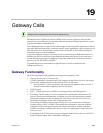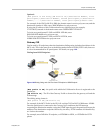
RealPresence Collaboration Server (RMX) 1500/2000/4000 Administrator’s Guide
19-2 Polycom, Inc.
ALWAYS_FORWARD_DTMF_IN_GW_SESSION_TO_ISDN System Flag to
system.cfg and setting its value to YES.
• Up to 80 gateway calls (same as conferences) may be run on a fully configured MCU.
• Gateway Profiles are included in the Backup and Restore Configuration operations.
• CDR files are generated for Gateway Sessions in the same way as for conferences.
• Cascading. To support cascading, the gateway indicates a lower number than the MCU
for master-slave relation (directly or through DMA).
• Gateway calls are supported in Microsoft and Avaya environments.
Call Flows
Call flow changes according to the connection protocols: IP or ISDN. This section describes
the call flows between two endpoints connect via one gateway. For call flows describing
connections between two endpoints via two gateways, or a connection of an endpoint to a
conference running on MCU via a gateway, see "Basic Cascading using ISDN Cascaded Link”
on page 5-5.
IP Participants
Two calling methods are available:
• Direct - the dialing string includes the destination number/conference ID and the call is
routed directly to the destination endpoint/conference. This is the recommended
method.
• Via Gateway IVR - the call connects to the gateway, where through interaction with the
IVR, the destination number is entered using DTMF codes.
Direct Dialing
The calling endpoint enters the dialing string that includes the access numbers to the
Collaboration Server Gateway Profile and the number of the destination endpoint. Up to 10
destination numbers can be entered in one string.
The call connects to the Collaboration Server Gateway Profile and a Gateway Session is created.
The dial-in participant is automatically connected to it.
During the connection phase, the number being dialed is displayed on the screen of the
calling endpoint.
If the call is not answered or it cannot be completed using one communication protocol, the
system will try to connect the endpoint using the next communication protocol according to
the selected protocols in the following order: H.323, SIP and ISDN. PSTN numbers are
identified separately and are dialed immediately without trying other connections.
If the call is busy, the system will not try to connect the endpoint using another protocol.
If the call is not completed after trying all possible protocols, the system displays the
number that was dialed on the calling endpoint’s screen and the reason for not completing
the call. For details, see "Connection Indications” on page 19-22.
When the call is connected, a new Gateway Session is created and added to the ongoing
Conferences list.


















